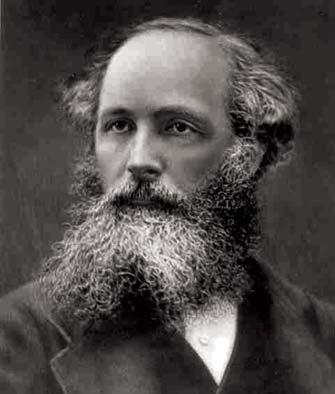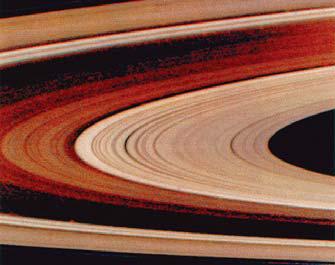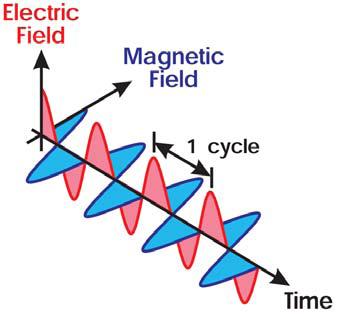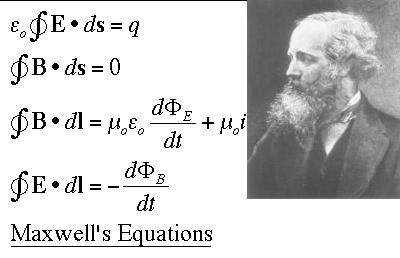135 years ago, the British scientist James Clark Maxwell published a book summarizing his research in the theory of electricity and sparked a revolution: in four mathematical equations he summarized a complete physical theory describing all knowledge about electricity and magnetism, which predicted the existence of electromagnetic waves and changed the face of the world
The article was published on the website tech times and is published on the Hedaan website courtesy of the author and the magazine system

Michael Farday, one of the most important physicists of the early 19th century and the father of the theory of electricity, once complained to his equally celebrated colleague, Andrei Ampere, about the tendency to describe every physical phenomenon with mathematical tools. "Every time an interesting phenomenon is discovered, it is translated into mathematical equations that I can't understand," he grumbled in the letter he sent to Lamper.
Ultimately, it was a mathematically inclined physicist who translated Faraday's controversial ideas into mathematical equations that changed the face of physics and gave birth to modern electromagnetic theory and the electronics industry.
His name is James Clerk Maxwell. A member of a rural noble family from Edinburgh, Scotland, who was born two months before Michael Farday published his surprising discovery in August 1831 that the movement of a magnet generates an electric current in a conducting wire. This discovery led to the discovery of the phenomenon of electromagnetic induction and the development of the first electric motor and generator, which Faraday built in his laboratory at the Royal Institution in London.
But Farday's attempt to explain the findings caused controversy. In the 19th century, the scientific picture of the world was based on Newton's physics, according to which all bodies in nature exert forces on each other through contact. In the first studies of electrical researchers, such as Faraday, Ampere, Kirchhoff and others, interesting electrical phenomena were indeed identified, but not the forces and "bodies" that generate them. This was one of the reasons why so much effort was put into the study of electricity in the Victorian period.
To explain the phenomenon of inspiration, Farday came up with the idea of "lines of force". According to this idea, the electric and magnetic forces have a kind of lines along which and in which direction they act in different types of media. The idea seemed to contradict Newton's laws, and provoked severe criticism in the scientific community. It took 40 years and a genius like Maxwell for the idea to be accepted by physicists.
A noble childhood
James Clark Maxwell was born into a rural aristocratic family, established but modest. His father had a legal education, but was mainly interested in scientific inventions. Maxwell's mother was 40 years old when she gave birth to him, and when he was 8 years old she died of stomach cancer. Maxwell himself died when he was her age, 48, and for the exact same reason.
After his mother's death, his education was handed over to his father, who instilled in him a strong love for science. He spent his childhood between Edinburgh and the family estate Glenair in the Galloway region of Scotland, where he often traveled in nature and also proved to be an amateur painter with a great talent for drawing.
Maxwell wrote his first scientific paper when he was 14 years old: How to draw an ellipse accurately using a pencil, thread and pins. At the age of 16 he began studying at the University of Edinburgh and at the age of 19 he moved to Cambridge. Unlike the academics of his time, he taught at several universities in Great Britain, and only in 1871 did he return to Cambridge, and was even appointed the first director of the famous Cavendish Laboratory.
He was the perfect product of the ideal of enlightened education. Along with his outstanding scientific achievements, he is considered a pleasant person with a well-developed sense of humor. He spoke in a soft and pleasant tone, was in love with his wife throughout his life and often wrote poems in which he processed his experiences and even mocked his addiction to mathematics.
The mystery of Saturn

As a mathematician by training, Maxwell was one of the developers of statistical mechanics, a theory designed to aid in the study of gases, and was used to describe the behavior of gases by the movement of molecules in the gas. Statistical mechanics also served him when he looked deep into outer space: for almost 200 years the rings around the planet Saturn were considered a mystery in the eyes of astronomers, since they were observed by Galileo in 1610 and the Dutch astronomer Huygens in 1660.
Only in the second half of the 19th century did the mystery begin to become clear. As a student at Cambridge, Maxwell wrote a paper in which he analyzed the structure of the rings and concluded, based on the known principles of mechanics, that they are made of a huge number of particles of different sizes.
To this day, this work is considered one of the first impressive applications of mathematics in solving physical problems. When the Voyager spacecraft approached Saturn in 1980 and took the first close-up pictures of the rings, Maxwell's analysis proved to be accurate.
Light and waves

The main subject that fascinated his attention since childhood was light. As a child he used to play with a polarizing lens, and then he tested the polarization of light on the surface of stretched gelatin. Maxwell was particularly interested in the wave phenomena of light and the colors that make up light, and his research led him to produce the world's first color image.
In 1861 he photographed a Scottish cloth film three times in a row, each image using a different color filter. He then projected the three slides onto a wall using three different projectors, each of which produced a different color using the filters used to take the photo. When the three images were focused on one point - a colored image of the checkered fabric appeared.
However, Maxwell's greatest work, which is still considered one of the most impressive physical theories and equal to the works of Newton and Einstein, was his contribution to the theory of electromagnetism. The theory was formulated in four equations of the electromagnetic field: equations that constitute a mathematical interpretation of Faraday's ideas, which convert the idea of lines of force into precise formulas.
A new world picture
From these equations emerged a new world picture of the relationship between magnetism and electricity. From the ideas they brought about how magnetism and electricity progress in space, a new theory of electromagnetic waves emerged: from radio waves through light rays to X-ray radiation and cosmic particles.
For more than 20 years, Maxwell was engaged in researching the phenomenon of electromagnetism and trying to merge Farday's ideas, along with other findings, into a unified mathematical theory. In 1873, exactly 135 years ago, he published his conclusions in the book Treatise on Electricity and Magnetism.
"As I progressed in studying Farday's research, I came to the conclusion that his method was also mathematical, even though it was not presented in the conventional form of mathematical equations. I also found that it is possible to represent these methods in an appropriate mathematical way". Maxwell wrote in the book.
The influence of the book was enormous, although in practice it only summarizes Maxwell's findings published over more than 20 years of research in many articles. Already in 1864, Maxwell estimated that "we have many reasons to assume that light itself, including heat radiation and other types of radiation, are electromagnetic disturbances in the form of waves that progress according to the laws of electromagnetics". However, it was only with the publication of the book, which includes all of Maxwell's equations and assumptions, that physicists recognized the importance - and revolutionaries - of his theory.
The ether and the speed of light

One of the spectacular results of Maxwell's interpretation of Farday is his conclusion that electrical and electromagnetic phenomena work through waves. Like Farday, he also rejected the idea that was accepted in his time, according to which these phenomena were a direct action of bodies coming into contact with each other. However, in order to reconcile with the Newtonian picture of the world, he believed in the existence of the invisible medium that was given the name Ether, which exists everywhere, even in a vacuum, and whose disturbances in this medium allow the passage of electromagnetic waves.
Using the equations he developed, he showed that the disturbances in this medium, the ether, are in the form of waves that are both electric and magnetic, and the speed at which they travel must correspond to the ratio between the electrostatic and electromagnetic units in which the electrical phenomenon is measured. This ratio gave a speed of 300 million meters per second. He was so close to the accepted estimate of the speed of light, that Maxwell wrote to Farday (1861) that "it is now possible to determine with certainty whether my claim that light and electromagnetism are two manifestations of one phenomenon is true or not."
Radio waves: the prediction that succeeded
The influence of Maxwell's theory was enormous, even though it took many years for all his ideas to be accepted and then implemented. In his efforts to unify the electrical theory, Maxwell encountered many problems, because many facts about the electrical properties of matter and the relationship between electricity and magnetism were not known at the time.
To overcome this, he employed various strategies, including using considerations of symmetry, mechanical models and intuition. For example, Maxwell's fourth equation states that two phenomena may cause a magnetic field: movement of an electric charge (current) and changes in the electric field. But the second phenomenon was not known in his day. For theoretical reasons, and in order to maintain the integrity of the equations, he hypothesized its existence and added to the equation another factor that he called a "copy current" - a kind of imaginary current that takes place in space due to the change in the electric field. In this way, one could say, he "invented" electromagnetic radiation.
Only 25 years after the publication of his book, the German physicist Heinrich Hertz succeeded in producing short electromagnetic waves, and proving that they behave like light waves: can be focused, reflected and polarized. But it was not easy.
The scientific community received the idea of electromagnetic waves with skepticism, because there was still no experimental result to confirm their existence.
In 1879, the year of Maxwell's death, the Academy of Sciences in Berlin announced a prize for whoever would discover electromagnetic waves and measure their speed of propagation, with the intention of proving that there is no independent field in which waves propagate at a finite speed.
Heinrich Hertz, professor at the University of Karlsruhe and son of a Jewish father, a lawyer who converted to Christianity like many Jews in Germany during the Enlightenment, entered the competition. Hertz's experimental system consisted of a transmitter and a receiver. The transmitter consisted of a voltage source, a coil and two metal spheres close to each other. The receiver was similar to the transmitter, but without a power source.
Hertz discovered that every time the voltage in the transmitter increased and a spark formed between the two marbles, a parallel, weaker spark appeared between the two marbles in the receiver. The conclusion was that the fluctuations of the electrical charges between the spheres in the first circuit created electromagnetic waves that spread in space and reached the second circuit. Later, Hertz performed a series of experiments in which he proved that these waves have all the properties of waves. He even measured their speed and showed that it is equal to the speed of light.
Heinrich Hertz's experiments in 1886-88 gave birth to the era of wireless communication. As early as 1896, the Italian Giuliello Marconi and the Russian Alexander Popov built radios that could transmit messages over short distances. In 1901 Marconi made the first transatlantic radio transmission.
The equations of the 20th century

Maxwell's equations had a decisive influence on the development of physics, electricity and the electronics industry. So much so that they were nicknamed "the equations of the 20th century". About two hundred years after the publication of Newton's principles of mechanics, a consolidated physical theory appeared once again, which is considered the highlight of classical physics.
Almost all technological developments in the last 100 years owe their existence to Maxwell's equations: wireless communication, the radar, the optical communication, the laser, the electric motor and more. Even the idea for the existence of the memristor: a fourth basic component alongside the resistor, capacitor and inductor, which was first proposed in 1971 by Prof. Leon Chua of Berkeley, California, is based on a careful analysis of Maxwell's equations.
Recently, the HP company announced that it was able to produce for the first time a meristor, which can be used as a passive memory component, thus creating an opening for a new revolution in the theory of the electric circuit. But alongside the successes, Maxwell's equations created challenges that science had to face unsuccessfully for more than 30 years. Questions that scientists had to wait until Albert Einstein published the general theory of relativity to solve.
Einstein's challenge
Like Maxwell, Albert Einstein was also very interested in the connection between light and electricity. In 1905 he published an article on the photovoltaic effect, which provides the first explanation for the connection between light and electricity and predicts the existence of a new particle: the photon. After that he began to deal with two other incomprehensible phenomena of Maxwell's theory: the ether and the application of Maxwell's equations in moving bodies.
The site was an unsolvable problem because it created attribution mechanisms that do not correspond to different phenomena. Maxwell's equations for moving bodies also created a problem: when a magnet moves near a wire that is at rest, the movement of the magnet creates an electric field that causes a current to appear in the wire. However, if the magnet is at rest and the wire is in motion, no electric field is created (although a current appears in the wire). The paradox arises from the fact that the phenomenon should have arisen due to the relative motion between the magnet and the wire, regardless of the question of which of them is at rest and which is in motion.
The 26-year-old Albert Einstein found a solution to the problem after a sudden enlightenment, and in June 1905 he submitted the article "On the Electrodynamics of Moving Bodies" to publication. In this article he developed the theory called "limited" (or "special") relativity. It was based on two assumptions: the speed of light in a vacuum is always constant, and the equations describing the laws of physics have the same form for any observer who is in free motion (that is, no forces are applied to him).
Disposal of the site
From the theory of relativity comes the relationship between mass and energy, the description of the universe as having four dimensions (including time), a new description of the essence of gravity, and of course, a fundamental change in electromagnetic theory: in Maxwell's equations, the electric field and the magnetic field appear as two separate entities. From the theory of special relativity it appears that the two fields are nothing but two sides of the same phenomenon. The asymmetry mentioned earlier is due to the fact that in one frame of reference an electric field can turn into a magnetic field, and vice versa.
The other result of the theory of relativity was the conclusion that Maxwell's equations are not affected by the existence or non-existence of the ether, therefore there is no need to assume its existence. Einstein removed from the history of physics the site that Maxwell was so fond of.
Maxwell's equations

Maxwell's equations can be written in different forms, some of them in the form of complex differential equations. Below is a simplified version of the equations, as written in Maxwell's handwriting in a special booklet produced by the IEEE in honor of the 150th anniversary of their publication.
1 An electric charge is the source of an electric field. In Farday's terms: the electric lines of force begin and end at the electric charge.
2 There is no magnetic charge. Therefore the lines of magnetic force always produce a closed circuit.
3 Electromotive force (Voltage) is created in a conductor when it passes through a magnetic field (crosses the lines of force).
4 The electric current is always surrounded by a magnetic field (or magnetic lines of force).
The main signs in Maxwell's equations:
D = electric flux density
ρ = electric charge density
B = magnetic flux density
H = strength of the magnetic field
E = electric field strength
= vector operator. Indicates that the equation refers to all directions in space
Sources:
• The universe according to modern physics / Prof. Yoram Kirsh. Published with an employee in 2006
• Lines and Waves: Faraday, Maxwell And 150 Years Of Electromagnetism / Robert D. Friedel. IEEE Spectrum 1981
• Maxwell's Legacy/James C. Rautio. IEEE Microwave Magazine/June 2005
• Molecules/James Clerk Maxwell. Nature/Sept 1873
for further reading:

23 תגובות
Hi Michael
Definitely agree, there was a comment about the reasons for the phenomenon to explain in which cases it will be emphasized more.
Higgs:
What I was trying to tell you is that you should know:
In science, experiment prevails over theory.
Michael
you should know Have you ever seen a computer without one or more internal clocks? Although the brain is structured differently, it also needs coordinated activation rates.
Michael
An electronic display that works with the scanning method creates a phenomenon of frequency differences when there is movement above a certain speed of the eye and of course when it is cyclical.
Vibration of the optic nerve will cause similar phenomena for certain frequencies also to fixed objects.
Because the eye also uses decay cycles. The neurons transmit the image according to the coordinated cycle rate in the brain. There is no fixed image but something similar to a cyclic sequence of scanning.
Higgs:
Did you do the experiment?
If you did them, Neyt sees that the matter has nothing to do with the electronic creation of the image, because the same phenomenon also occurs with letters on a sheet of paper.
See my response above.
Jonathan
The vibration is created in a similar way to interference due to show differences.
When the electronic mechanism that feeds the information to the digits of the watch operates in the scanning method (SCAN), that is, the digits are connected in a matrix and are illuminated one after the other very quickly.
At any given moment only one digit is illuminated and the rest are off or in a decaying state.
When the scanning is fast enough (can be 1000 times per second) the image in the eye fades much more slowly, so you see a continuous image. However, when there is an external vibration on the optic nerves, there is a mixing between this vibration and the vibration of turning the digits on and off. And another image is created that presents the frequency of the differences in the show. The same situation happens when videotaping a TV or computer screen.
The waves that appear on the video screen are created thanks to these show differences.
Maxwell expressed his discovery in ten equations. The sum of the electromagnetic theory in four equations is later
Jonathan,
This is an interesting but familiar phenomenon that the best researchers have dedicated their years to. The experiment you conducted can be perfected as follows: hold the massager with one hand, turn it on and attach it to your head. Be sure to keep your eye on the digital numbers at all times. Take a metal nail with your free hand, insert the nail into the nearest electrical outlet. To the greatest amazement, you will see that the numbers on the clock turn into stars in many colors.
: )
Yonatan, Aryeh and the cool:
I did some experiments myself and I got the impression that what affects here is not the network frequency but a combination of three parameters:
The first parameter is the degree of sharpness with which the eye sees the observed object;
The second parameter is the distance of the observed object from the eye;
The third parameter (which affects less) is the size of the observed object.
In all the mentioned attempts it is indeed the shaking of the head and the fact that this shaking moves the image across the retina in a way that the brain does not know how to offset.
The role of the second parameter is clear:
The smaller the distance of the observed object, the greater the change in its position on the surface of the retina.
The role of the third parameter is that the larger the observed object, the smaller the change in its position appears (and the effect of the size of the large object disappears if you focus your gaze on a certain point on its surface).
The role of the first parameter is that when a certain object is not clearly visible, its location is not exactly known to the brain anyway, and therefore the change in location is less noticeable.
Clock digits tend to be sharp.
Since I also conducted the experiment with objects that are not electronic images and saw the vibration in them as well, I tend to rule out the effect of the network frequency.
If anyone has a device with illuminated digits that is operated by direct current, it will be possible to check the issue from another direction.
Since it is, after all, a personal experience experienced by each one individually, I cannot be sure that what I notice in me is also valid for you, but you are welcome to try and report.
the cool I didn't understand what you said.
What phenomenon are you talking about?
What do I have to do to see her?
Bona Jonathan, you are huge!
I thought I was the only one who noticed that the digits on the clock in my room had a tendency to vibrate.
You will notice that even if you grind your teeth you can notice it.
There could be several reasons, one already mentioned and the other, which I thought about and I'm not sure how reliable it is:
1) The frequency of the backlight of the clock is low 50 Hz or below.
2) The light sensors in the eye have a higher sensitivity to stronger lighting, so when the relative position in the eye of the illuminated clock digits changes, then the speed with which the eye updates the brain with the change in the position of the clock digits is faster than the speed with which its surroundings change position (the closet, cabinet, frame, shelf, wall, etc.) more than the clock numbers).
Think about what I wrote and respond, thanks.
Thanks
In my opinion, Maxwell does not receive the public attention he deserves, he is too much in the shadow of Newton and Einstein. By any standard you check, he does not fall short of them in any way. And by the way, his book Treatise on Electricity and Magnetism is one of the most readable books of that period, and is recommended for those interested in the history of electromagnetism.
Small correction to the article: in the third paragraph where it says 1931 should be 1831
Jonathan, the detail of the explanation.
The digits turn off and on, your eyes move (with the whole skull), but the brain doesn't know about it, so every time the digits turn on, the brain interprets it as the digits moving - like in a movie, because the brain doesn't know that the eyes have moved.
In a normal situation when you move your head then the brain knows that what is moving is the head and not the thing you are seeing and therefore you do not interpret it as a movement of the observed object.
To Aria and Alex - thanks for the answer. It seems to me that this is the right direction, but I still haven't been able to understand the connection between the electrical frequency and the vibration of the digits. I would appreciate it if you could elaborate.
Arya is right
Jonathan. You need to see a doctor… :)
Jonathan - there is no connection between your question and the subject of the article, but the phenomenon you describe is probably related to the fact that the illumination of the digital digits is not continuous but changes according to the frequency of the electrical grid (fifty cycles per second) and at the same time your eyes are vibrating because you have activated the massage device on your head or spine.
Excellent article.
I encountered an interesting phenomenon.
If I take an electric massager and turn it on and attach it to my head or the upper part of my spine and at the same time look at the digital digits of the alarm clock next to the bed - the digital digits vibrate.
The problem is that no object other than digital numbers and letters vibrates, including letters printed on the watch.
Can anyone explain the phenomenon?
This Maxwell ruined my mood for all his equations in the horrible Physics 2 course..
It is written that Hertz's father was originally Jewish.
Not Maxwell's.
Interesting article.
Why don't you read the article? It is explicitly written that his father was a Jew who converted to Christianity.
Are you sure Maxwell wasn't a bit Jewish? Maybe a quarter Jewish? Something, must be.